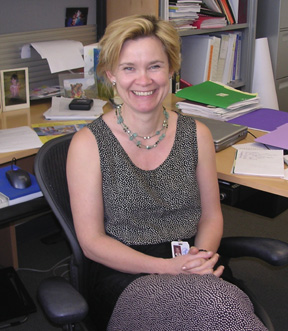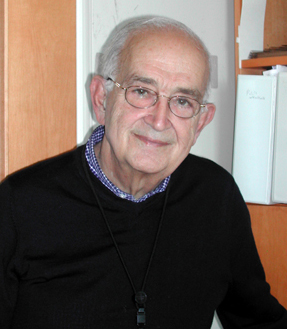| T
H E N I H C A T A L
Y S T |
M
A Y – J U
N E 2005 |
|
The
Comeback Vaccine
FIRST-
AND SECOND-
GENERATION ROTAVIRUS
VACCINES
POISED
TO PREVENT MAJOR
CAUSE OF PEDIATRIC DEATHS
|
by Fran
Pollner
|
 |
 |
Lone
Simonsen (left), senior epidemiologist in the NIAID Office of Global
Affairs,reanalyzed the CDC data that led to the withdrawal of the orginal
rotavirus vaccine from the U.S. market. Her work counters the CDC intussusception
projections and establishes a basis for a different rotavirus vaccine
dosage schedule. "Her data are key," says Al Kapikian (right),
to the confidence with which he and his team present their new rotavirus
vaccine and schedule to the world. Companion articles* by Kapikian et
al.
(*1) and
Simonsen et
al.(*2)
on
the safety of rotaviral vaccines and prospects for eradicating severe
rotaviral disease will be published in September in a supplement to
the Journal
of Infectious Diseases
|
After
nearly six years in limbo, rotavirus vaccines developed in Al
Kapikian’s NIAID lab are back on track to worldwide distribution and
the prevention of the severe rotavirus-associated diarrhea that kills 500,000
to 600,000 infants and young children annually.
Over the past few years,
10 companies in the United States and abroad have been negotiating licensing
agreements with the NIH Office of Technology
Transfer (OTT) for the right to manufacture and market one or the other
of the NIH rotavirus vaccine inventions (see "OTT
and Rotavirus Vaccine").
One company has secured
the rights to RotaShield, which was the first and only FDA-approved rotavirus
vaccine and had been on the market only nine months when it was withdrawn in
1999 on the heels of a CDC report showing a vaccine-asociated risk of intussusception
(intestinal prolapse). Nine other companies have scrambled to pick up where
testing left off for the second-generation version of the vaccine.
Chief among the factors
contributing to this revived interest are:
 A reanalysis of the intussusception data from the CDC study pointed to a compensatory
decreased risk within the first year of life, suggesting the overall risk had
been overestimated.
A reanalysis of the intussusception data from the CDC study pointed to a compensatory
decreased risk within the first year of life, suggesting the overall risk had
been overestimated.
 Further analysis uncovered an age-related vulnerability that pointed to an even
safer alternative vaccine-delivery schedule than originally recommended.
Further analysis uncovered an age-related vulnerability that pointed to an even
safer alternative vaccine-delivery schedule than originally recommended.
Kapikian believes that
this revised schedule has the potential to eliminatethe risk of intussusception
following vaccination—and he is jubilant that the vaccines are on the threshold
of delivery to high-mortality areas.
Global
Distribution
"It will be a great
thing to be able to say that this vaccine is finally where it is most needed—in
the developing countries where so many children have died from this preventable
disease," Kapikian said in an interview in April, shortly after his return
from Brazil, where he was honored at a ceremony to celebrate the signing of
a licensing agreement between OTT and the Butantan Institute of São Paulo.
"And what is really
wonderful," he said of the situation in Brazil, "is that the vaccine
will be free for every child. The Butantan Institute is state funded and produces
81 percent of all the vaccines in the country—that’s 188 million doses."
The vaccine licensed to
the Butantan Institute is the second-generation bovine rotavirus–human
rotavirus reassortant vaccine, which was developed alongside the rhesus-human
reassortant vaccine that was licensed and marketed as RotaShield (see "The
Ups and Downs").
For use in Brazil, the
basic quadrivalent vaccine will be augmented with the serotype 9 strain. Serotype
9, says Kapikian, has emerged as an important strain in Latin America and the
most important serotype in parts of Brazil. Serotype 8, he notes, is prevalent
in certain African countries—"and we will put that strain in our vaccine
for Africa. And when we do the vaccine for India, we will undoubtedly put in
serotype 9."
In a paper1 that
will be published in September in a supplement to the Journal of Infectious
Diseases, Kapikian and his colleagues recommend a hexavalent design (strains
1, 2, 3, 4, 8, and 9) for many of the developing countries. "The first
four of these reassortants were made by Dr. Karen
Midthun and others in our lab, and serotypes 8 and 9 were made later by
Dr. [Yasutaka] Hoshino—next
door—and they are available to be added to the vaccine," Kapikian
notes. As licenses with OTT are concluded, the team will be sending relevant
strains to each licensee.
He expects his work for
the next few years will be focused on assisting the licensees in adapting the
vaccine to the realities in their areas. His lab will provide technical assistance
and, as space permits, will serve as a training site for those seeking to update
relevant lab skills. Such a request has already come from China, where licenses
are pending with three different entities.
Kapikian is pleased to
point out that the advice he gives—regarding vaccine design, dosage schedule,
and clinical trial protocol—to the many manufacturers who would bring the
vaccine to their countries is part and parcel of his responsibilities as an
NIH scientist with a public health mission.
| THE
UPS AND DOWNS OF ROTAVIRUS
VACCINE |
|
Al Kapikian’s
rotavirus research—first on the nature of rotavirus infection and
then on a vaccine to undercut the otherwise potentially fatal severity
of the first episode–began in 1974 and involved clinical collaboration
with Children’s Hospital National Medical Center, Washington, D.C.,
and clinical trial collaboration with centers in the United States and
overseas, as well as a CRADA with Wyeth and contracts with DynCorp.
That work culminated
in July 1998 with FDA approval of the Kapikian team’s quadrivalent,
live-virus oral vaccine. Wyeth received a product license from the FDA
and took the vaccine—called RotaShield—to market with the recommended
schedule of three doses delivered at 2, 4, and 6 months of age. The CDC
Advisory Committee on Immunization Practices (ACIP) endorsed the routine
use of the vaccine at the recommended schedule.
A rhesus rotavirus–human
rotavirus reassortant, the vaccine was designed to raise antibodies to
rotavirus strains prevalent in the United States—G1, G2, G3, and
G4—and to be augmented with additional strains as needed in other
areas of the world.
Alongside the rhesus-human
vaccine construct, the team had also developed and was testing a bovine-human
reassortant vaccine, which—in clinical trials in Finland—was
proving to be as effective as the rhesus-based product and also to be
free of the self-limited but bothersome fever experienced by about a third
of those given RotaShield.
In July 1999, however,
the CDC
published findings of increased intussusception risk within two weeks
of RotaShield vaccination, especially after the first dose. Based on initial
studies and Adverse Events Reporting, the CDC initially estimated the
risk to be about one excess intussusception in 2,500 to 5,000 vaccinated
infants.
The ACIP withdrew
its recommendation in October 1999, and Wyeth withdrew RotaShield from
the market, suspending the introduction elsewhere of the rhesus-human
vaccine, the evaluation of the bovine-human vaccine, and what was to have
been a long-awaited worldwide campaign against severe rotavirus disease.
(See The NIH Catalyst, March-April
1999 and March-April
2000, for previous coverage of the vaccine’s approval and subsequent
withdrawal from the U.S. market.)
Since that time,
NIAID investigators have reanalyzed the CDC data and proposed that a two-dose
schedule, the first dose at 0 to 4 weeks and the second at 4 to 8 weeks,
may virtually eliminate intussusception risk associated with rotavirus
vaccine.
Their published
reports1-4 and presentations
at international meetings have generated a worldwide interest in these
NIAID vaccines that has translated into licensing agreements between the
NIH Office of Technology Transfer
and companies around the world.
—Fran
Pollner
|
The
Road to Establishing Safety
From the time the rug
was pulled out from under RotaShield, NIAID scientists set to work to understand
theunexpected turn
of events. Lone Simonsen, now senior
epidemiologist in the NIAID Office of Global Affairs, recalls that NIAID was
"caught unaware" when the CDC reported on the intussusception association
in the MMWR
of May 16, 1999. "They had never seen the data." Simonsen was
called in to take a look at the evidence.
She cites three major
findings in a series of reports from 2001 to the present. (see the two papers
cited below3,4.)
First, during the nine-month
period the vaccine was used, there was no increase in intussusception in states
using the vaccine, contradicting the impression that the increased relative
risk in the immediate postvaccination week would mean the vaccine had caused
a substantial number of intussusception events.
"The important point
was that, no, this was not a public health disaster," Simonsen said in
an interview. "To explain the unchanging intussusception rates during the
nine-month use period, we hypothesized that the vaccine was harvesting events
that would have happened anyway—and then, working further with the CDC
case-control database, we found the phenomenon of compensatory decrease over
time. This observation strongly supported our harvesting hypothesis."
Still concerned about
the intussusception risk in the immediate postvaccination weeks, Simonsen and
her colleagues set out to study carefully the role of age as a risk factor,
analyzing data from the CDC, the National Center for Health Statistics National
Immunization Survey, and hospital discharge data from the Agency for Healthcare
Research and Quality.
During the nine-month
introductory period for RotaShield use, many infants received the first dose
beyond 2 months of age—so they could "catch-up" to the recommended
schedule. More than 35 percent of first doses were
given to "catch-up" infants between 3 and 7 months of age, and more
than 80 percent of all implicated intussusception cases were amongst these older
infants, Simonsen said.
"Were immunization
to be completed before 3 months of age, we project that the intussusception
risk would be far lower than previously thought—and comparable to severe
adverse events linked to other approvedvaccines
currently in use," she said. In this scenario, RotaShield could be reconsidered
for use—even in the United States, where the rotavirus burden of disease
(though real, with 50,000 hospitalizations and 20 deaths a year) pales before
the global toll.
Kapikian notes that in
the natural history of intussusception, the first two months of life is a relatively
refractory period, while peak incidence is between 3 to 4 months and 9 months.
The cause of intussusception is not known, but, he says, it makes sense to give
the vaccine before the peak period of susceptibility. 
Lone
Simonsen and Al Kapikian wish to acknowledge the late John La Montagne, NIAID
deputy director who died in November 2004, for being a source of strength, support,
and encouragement in this unfolding rotavirus vaccine saga.
* The two companion papers
to appear in a September supplement to the Journal of Infectious Diseases
are:
* 1.
A. Kapikian, L. Simonsen, T. Vesikari, Y. Hoshino, D. Morens, R. Chanock, J.
La Montagne, and B. Murphy, "A hexavalent human-bovine reassortant vaccine
designed for use in developing countries and delivered in a schedule with the
potential to eliminate the risk of intussusception," J.Infect.Dis.
(in press, 2005)
*
2. L. Simonsen, C. Viboud, A. Elixhauser, R. Taylor, and A. Kapikian,"More
on RotaShield and intussusception: the role of age at vaccination," J.Infect.Dis.
(in press, 2005).
3.
L. Simonsen, D. Morens, A. Elixhauser, M. Gerber, M. Van Raden, and W. C. Blackwelder,
"Effect of rotavirus vaccination programme on trends in admission of infants
to hospital for intussusception," Lancet
358:1224 (2001).
4. B. Murphy, D.
Morens, L. Simonsen, R. Chanock, J. La Montagne, and A. Kapikian, "Reappraisal
of the association of intussusception with the licensed live rotavirus vaccine
challenges initial conclusions," J.Infect.Dis.187:1301
(2003).
Return to Table of Contents

